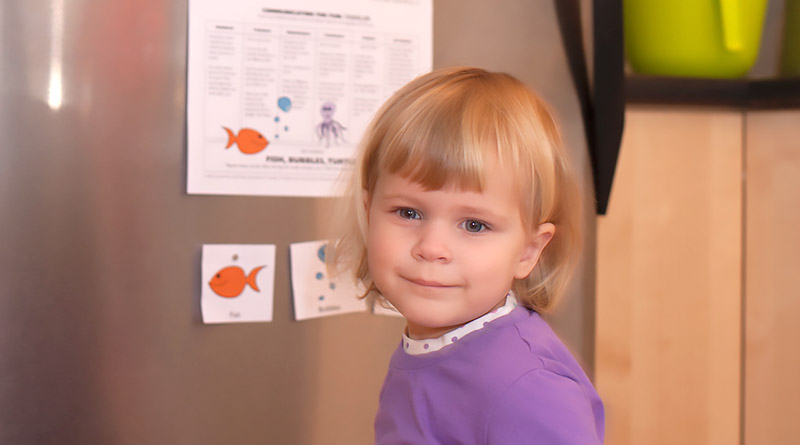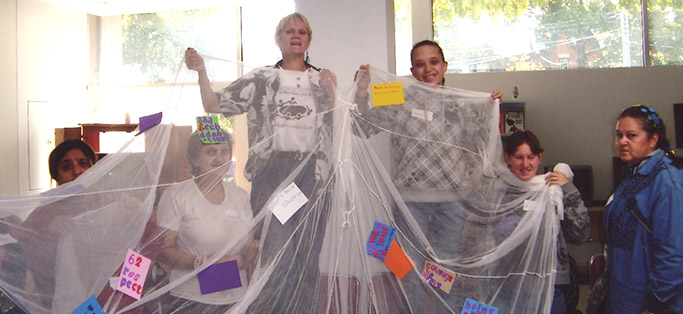Parent and Child Activity Calendars to Promote Better Speech, Language and Hearing

About the Calendars
The Calendars provide activities for all children, but will be very helpful for children who have special needs. These are activities that you and your child can do together. The calendar activities are available for three age groups and reflect distinct developmental stages. Children with special needs may develop at a different or slower rate than other children. To find out what stage your child is at, look at the Developmental Milestones Chart from the Preschool Speech and Language Program.
The calendars have activities for each day of the week. Every week has a theme which makes the activities fun and interesting. You can choose a calendar for each season, or for special holidays, as well as for everyday activities.
Key Words
On the bottom of each calendar there are some key words to use throughout the week with your child. The key words reflect the theme of the calendar and will help to build your child’s vocabulary, language and listening skills. Young children are not learning to spell words but should be starting to recognize the sounds of words and letters. Oral language (talking and understanding words) is the start of learning to read and write. On the second page there is a picture with each of the key words. You can print the Calendar and the key word pictures and put them on your fridge or on the wall where your child will see them everyday. Looking at the pictures and naming the item will help your child to recognize the word. Using the word in a sentence or story will help younger children to recognize the word and older children to understand how to use the word when they are talking.
The aim of the activities and key words is to develop better communication skills:
- hearing (listening),
- speech (sounds, words), and
- language (message, ideas).
The calendars provide a focus on speech, language and hearing skills as your child explores, learning more about themselves, others, and the world around them.
Families may:
- take longer than a week to do the activities
- choose only some of the activities
- do the activities in a different order
- adapt or vary the activities
- do different or extra activities
There is no right or wrong way to use the calendars. They are to help your child by providing lots of chances to play and learn. Many of the activities will be ones that you already do with your child. The difference is that you will be thinking about your child’s speaking and listening skills and providing your child with the chance to learn new words and expand their communication skills.
Communicating with Your Child
Some helpful pointers when talking and communicating with your child:
- Become involved in what your child is doing – talk and ask questions about the activity.
- Play, read, and listen to music with your child – be excited.
- When your child points, makes faces, or makes a sound -put words to it and describe what they see or do.
- Don’t do all the talking – give your child a turn to talk.
- Praise your child – recognize your child’s efforts to communicate.
- When playing and talking with your child make sure you are face to face with them – sit on the floor, bend to their level.
- Encourage your child to use words and talk as much as possible.
- Have fun!
For more ideas about helping your child to communicate check out the Tip Sheet section for the stage that your child has reached.
Toddler Communication Calendars
Calendar Tips for Toddlers
Most Toddlers Will:
- Understand more words than they can say.
- Follow simple directions (such as: “Show me your ear.”, or, “Put the doll to bed.”).
- Answer “yes” or “no” questions.
- Make animal sounds.
- Use two to four word sentences (“More juice”, “Me do it”).
- Use describing words (big tree, hot food).
- Enjoy listening to stories, songs, and rhyme.
- Have short conversations with people they know.
Things to Keep in Mind When Helping Your Toddler:
- Talk slowly and clearly, using 2 to 4 word sentences.
- Label everything – point to items and say the name “Table, Daddy’s chair, your chair.”
- Tell the child what you are doing – describe your actions. “I am stirring the pot.”
- Read books with pictures. Point to the pictures and describe what you see. “Look at the funny bear.”
- When your child labels an object, expand on it. (When your child says, “Flower”, you say, “Pretty flower” or “Yellow flower.”)
- When your child tries to say a new word, repeat it. Encourage every new word.
- Do the calendar activities with other children so that your child can practice talking and listening, and learn how to communicate with others.
Are You Concerned about your Toddler’s Speech, Language or Hearing?
Seek Help if your Toddler:
- Has repeated ear infections.
- Does not play or is not interested in others.
- Has problems making him/herself understood.
- Speaks using very few words, or never puts two or more words together.
Trust your Instincts!! You know your child best and if you have concerns contact the Preschool Speech and Language Program or Infant Hearing Program in your community. You do not need a referral from a Doctor and the program is free to residents of Ontario.
Preschoolers Communication Calendars
Calendar Tips for Preschoolers
Most Preschoolers Will:
- Use sentences with 4 to 6 words. (“I go get my doll.”)
- Give and follow directions.
- Understand the meaning of in, on, and under.
- Tell stories and sing songs.
- Ask and answer questions, such as who, what, where, why.
- Makes themselves understood by other people 60% of the time.
Things to Keep in Mind When Helping your Preschooler:
- When playing games together, take turns with your child.
- Count everything.
- Provide your child with chances to choose (“Do you want to wear your red or blue shirt?”)
- Use picture books and have your child come up with his/her own story.
- Do the laundry together. Sort clothes by colour, where they belong, type of clothing.
- Pretend with your child, with or without toys.
- Sing songs, say rhymes, do finger plays and do all the actions with your child.
- Talk with your child about things that are the same and things that are different.
- Encourage your child to play with other children.
Are You Concerned about your Preschoolers Speech, Language or Hearing?
Seek Help if your preschooler:
- Becomes frustrated when trying to communicate.
- Repeats words, but does not know what they mean.
- Puts only two words together at a time.
- Has problems listening and being understood.
- Stutters often.
Trust your Instincts!! You know your child best and if you have concerns contact the Preschool Speech and Language Program or Infant Hearing Program in your community. You do not need a referral from a Doctor and the program is free to residents of Ontario.
Kindergarten Communication Calendars
Calendar Tips for Kindergarten
Most Kindergarten Age Children Will:
- Follow three-step instructions, such as: “Pick up your coat, hang it up, and close the closet door.”
- Answer open-ended questions: “What do you think?”
- Tell or repeat stories using detail.
- Use complete sentences, like that of an adult.
- Use describing words in their sentences, such as: small/big, under/over.
- Know most colours and numbers up to 20.
- Explain the meaning of words they know.
- Be able to problem solve, figure simple things out.
- Start to recognize letters and their sounds, as well as certain signs (eg. stop sign)
Things to Keep in Mind When Helping the Kindergarten Age Child:
- When labeling objects, encourage your child to use the word/object in a sentence. (“Teddy bear” – “That is a big, soft teddy bear.”)
- Read books related to the weekly themes. While reading stories, talk about what is happening in the book. Ask questions such as, “What do you think will happen next?”
- Build on what your child is saying. (Name the colours of each object-red, green; use the names of flowers-tulip, rose; name the parts of trees- trunk, leaves)
- Give your child little jobs. When you make a craft, let them do the cutting; when cleaning around the house give them a job they can do weekly; have them describe the weather every day.
- When doing the activities, give your child choices. (“Do you want the blue or red paper?”; “Do you want to set the table for lunch or supper?”)
Are You Concerned about your Kindergarten Age child’s Speech, Language or Hearing?
Seek help if your Kindergarten age child:
- Doesn’t talk, listen, or mix with other children or adults.
- Has a hard time following directions.
- Does not speak in sentences.
- Cannot get other people to understand them
Trust your Instincts!! You know your child best and if you have concerns contact the Preschool Speech and Language Program or Infant Hearing Program in your community. You do not need a referral from a Doctor and the program is free to residents of Ontario.
If your child has already started school talk to the Classroom Teacher about your concerns. The school Principal can make the necessary referrals to have your child screened or assessed by a Speech-Language Pathologist.
Calendar Tips for Professionals
Using the Communicating for Fun Calendars
Communicating for Fun Parent and Child Activity Calendars are designed to help all children with activities that promote speech, language and listening skills. Incorporating the calendars into your child care programs is a way Communicating for Fun calendars can be used for the benefit of all children. The activities can easily be extended and adapted to fit your program. Copies of a theme calendar may also be sent home with each child to accompany your program theme.
Calendars
- The calendars have been divided into three different age groups – Toddler, Preschooler, and Kindergarten Age.
- Each of the age groups share 20 common themes for each of the 20 weeks – in total, there are 60 different calendars. Themes include special holidays, seasons, animals, transportation and everyday events.
- Each week you can display a calendar and highlight the activities you are going to include in your daily program.
- Copies of the calendars and the Key Word graphics can be sent home with parents to hang on their fridge or notice board.
Age Specific Tip Sections
Tip Sheets have been developed for each age group and include a list of the skills most children of that age will have and suggestions on how to interact with the child to promote communication. The suggestions are geared to each developmental stage.
Concerned about a Child’s Hearing, Speech or Language?
The age specific Tip Sheet Sections also identify indicators that could suggest that the child may need extra help and a referral to a Speech-Language Pathologist or an Audiologist. Parents that are concerned can contact the Preschool Speech and Language Programs or the Infant Hearing Program in their community for help.
As the professional involved with the child, you may need to encourage or support a parent to make the connection with these programs. The Preschool Speech and Language Program Brochures provide lists of Developmental Milestones for Babies and for Preschoolers. You can print the brochures and review the information with the parent. The lists are available in 16 different languages.
Services from the Preschool Speech and Language Program or the Infant Hearing program do not require a Doctor’s referral and are free to residents of Ontario.
SOURCE: Ontario Association for Families of Children with Communication Disorders (OAFCCD) and Community Living Tillsonburg (2009)








